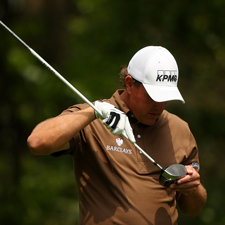During the first round of the Masters, there were times Phil Mickelson seemed to have a few screws loose when he had driver in his hands — both figuratively, like on the 10th hole when he couldn’t even find his tee shot en route to a triple-bogey, and literally, when on the 18th tee he consulted with a Rules official because one of the weights in his driver had become loose. As it turned out, Phil was permitted to tighten it because it had become loose in the “normal course of play”, meaning that he could repair the club back to its original state.
Rule 4-3 covers when and how a club can be repaired when it becomes damaged. The question we have to ask is was it damaged in the “normal course of play”. Decision 4-3/1 explains some situations where a club would be considered damaged in the “normal course of play”. Besides the usual examples when a club breaks during a stroke or practice stroke/swing, some others would be removing a club from your bag, using it to retrieve a golf ball and even using a club as a cane. Some examples that would not fall under damaged in the “normal course of play” would be after it has been thrown in anger or snapped over your knee. The theme here is a club that has been damaged because of anything other than anger can generally be repaired and sometimes replaced.
In Phil’s situation, he only had two options. He could have continued to use the club with the loose screw or without unduly delaying play, repair it, which is what he did. The only way he would have had the third option of replacing the club would have been if it had been considered unfit for play. The Note in Rule 4-3 states that “a club is unfit for play if it is substantially damaged, e.g., the shaft is dented, significantly bent or breaks into pieces; the clubhead becomes loose, detached or significantly deformed; or the grip becomes loose.” And it goes on to say, “a club is not unfit for play solely because the club’s lie or loft has been altered, or the clubhead is scratched.” Because Phil’s driver did not meet the definition of “unfit for play”, he could only repair it, which was fairly simple as he had the specific tool in his bag to tighten the loose screw.
In this scenario, if Phil (who started his round with 14 clubs) had simply replaced the driver with another club he would be in breach of Rule 4-4 for carrying too many clubs. He would have incurred a two-stroke penalty at the 18th hole and, if someone informed him of this breach, would be required to declare the newly replaced club out of play. If he failed to declare the club out of play, he would be disqualified. Furthermore, should this have occurred on the 9th hole for example, and Phil was not informed of his breach until the 13th hole, he would have incurred a two-stroke penalty on the 9th and 10th holes and been required to declare the club out of play on the 13th hole. He would not incur a two-stroke penalty on holes 11-13 because the most you can be penalized under this Rule is four strokes, two strokes per hole for a maximum of two holes.
Luckily for Phil he knew he couldn’t replace the club, but could repair it. “Fortunately you can just tighten it up; it was no big deal,” he said.


